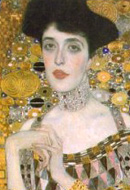The Mona Lisa of Vienna

In 1857, when Emperor Franz-Joseph pulled down the ancient stone wall encompassing Vienna, the social and cultural traditions of the country seemed to tumble with it. Impoverished immigrants, many of them Jews, flooded in from the east, changing not only the countenance of the city but its economic, intellectual, and psychological currency. The Ringstrasse—the wide boulevard that replaced the wall—became a proving ground for newly minted industrialists who eagerly displayed their earned status by building palaces alongside those of the propertied aristocracy.
Moritz Bauer, a German-Jewish immigrant, banker, and railway proprietor, was one such nouveau riche; he and his family, especially his daughter Adele, figure centrally in a new book by Anne-Marie O'Connor, a writer for the Washington Post. The Lady in Gold: The Extraordinary Tale of Gustav Klimt's Masterpiece, Portrait of Adele Bloch-Bauer, is a tour de force, telling a story-within-a-story that is continually engrossing if not always satisfying. O'Connor weds medicine, industry, and romance with the avant-garde strains of turn-of-the-century Viennese art, capturing a moment in time when creativity, hedonism, delusion—and anti-Semitism—ran rampant. This is the Vienna limned unforgettably by Stefan Zweig in his autobiography The World of Yesterday (1942) and etched in acid by Arthur Schnitzler in his 1908 novel, The Road into the Open. But if this is how O'Connor's story opens, the principal burden of her narrative lies elsewhere, in her wide-eyed journey out of the late-19th century and toward the mid-20th-century Nazi apocalypse.
The saga begins in 1898 as Adele Bauer, a woman-child of sixteen dressed in a Grecian gown, is toasting the imminent marriage of her sister Therese to Gustav Bloch, scion of a German-Jewish beet-sugar mogul. Within a year, Adele will marry Gustav's brother Ferdinand, twice her age but more than wealthy enough to get her out and into society. Barred from study at a university despite her intelligence and rapacious curiosity, Adele hosts a salon in their lavish home that attracts the fiery new artists and socialists who will define Vienna's "age of freedom."
In 1903, as a token of his adoration, Ferdinand Bloch commissions Gustav Klimt, the devilishly handsome experimental painter and favorite bad-boy of wealthy Viennese Jews, to paint her portrait. Three years in the making, the painting, roughly four-and-a-half-feet square, renders her in Byzantine-mosaic style, bejeweled and robed in a suggestively ornamented, tight-fitting gold and silver garment against a swarming golden throne and a backdrop of mottled gold. She and Klimt conduct a lengthy affair—or, perhaps, not. In 1912 he paints a second portrait of her. By 1919, when the art- and artist-collecting couple moves to a new and even grander palace, Adele will dedicate a shrine to Klimt in her chambers.
Progressively sickly, Adele dies of meningitis in 1925, at the age of forty-four. Klimt falls into disrepute, and in the 1930s the gorgeous portrait, the Mona Lisa of a lost era, is confiscated by the Nazis and seems to disappear into nothingness.
And then? As the reader awaits with breathless anticipation—we are at this point only at page 71 of a 360-page book—O'Connor, as if discovering for the first time the horrible truth of Nazi racial policies, can't stop writing about them for well over a hundred pages. She graphically chronicles the rise of German-Austrian anti-Semitism and the torture, exile, and extermination of most of the Bloch-Bauer heirs. Only much farther on does she return belatedly to the painting and its fate. Now playing the role of an investigative journalist into the post-World War II politics of restitution, O'Connor unveils the stubborn treachery of the Austrian government in its determination to hold on to pre-war Jewish property, and the lingering influence of the anti-Semitic past.
Nonetheless, the story ends well. Thanks to the perseverance of Adele's niece, Maria Altmann of Los Angeles, and Altmann's clever and devoted lawyer E. Randol Schoenberg (a grandson of the Austrian-Jewish composer Arnold Schoenberg), the portrait now occupies pride of place in the Neue Galerie in New York City. Purchased at auction in 2006 by the philanthropist and cosmetics heir Ronald Lauder, for a record-breaking $135 million, The Lady in Gold has shed the Aryanized appellation by which it had become known and has reclaimed its original and true name, A Portrait of Adele Bloch-Bauer.
The magnificence of Klimt's painting, an emblem at once of the feverish culture of fin-de-siècle Vienna and the golden dreams of so many generations of European Jews, cannot be denied. But Adele's grave tells the real story. It lies undocumented in Vienna's Central Cemetery, where, we read, administrators brush aside O'Connor's inquiries about its location with "Jüdische? Jüdische? Nein!" Intent on closure, O'Connor searches the graveyard on her own until she lights upon what she came for: a black-gray granite plaque lettered in tarnished gold. Dried brown stems of blooms long dead lie at its base, as Adele Bloch-Bauer drifts untended and unadorned into oblivion.
Susan Hertog is the author of two biographies: Anne Morrow Lindbergh: Her Life and Dangerous Ambition: Rebecca West and Dorothy Thompson: New Women in Search of Love and Power.
Klimt's use of gold may go back to his father who was a goldsmith, but it was abundant in many of his paintings.
merci Thank you.
Comments are closed for this article.




